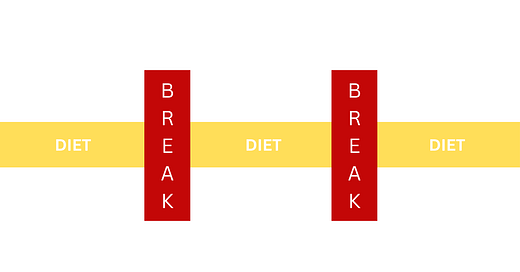Overcome Your Diet Plateau.... With Science
You've gotten far in losing fat and just can't get over the hump. Heres what you're missing.....
What is a Diet Break?
Over the past decade, fitness experts alike have observed the significant impact of diet breaks, when managing clients' weight loss journeys. Diet are like strategic retreats in a battle of fat loss, allowing for your body to regroup and re-engage, when it’s time to diet again.
Successful dieting involves not just timely adjustments but also incorporating diet breaks. These are defined as scheduled periods, usually lasting 2-6 weeks, during which calorie intake is increased and dietary tracking is relaxed. This strategy helps alleviate the constant strain of dieting, facilitating easier adherence, especially crucial for those with substantial fat to lose or those striving for extreme leanness, where the body increasingly resists weight loss.
Advisors commonly recommend a two- six week diet break for individuals who are dieting for extended periods, such as over three months. For those needing to lose significant amounts of fat, repeated diet breaks should be considered. Those aiming for high levels of leanness might need more frequent breaks, roughly every 6-8 weeks, based on their physical and emotional condition.
Neglecting diet breaks can lead to detrimental effects, underscoring that their importance transcends mere mental toughness or commitment. It's about recognizing and respecting the body's limitations to sustain prolonged dietary restrictions. Your body relies on proper caloric intake to maintain and function. Everything from breathing to digestion utilize caloric energy to function.
The Concept of Nutrition Periodization
Diet breaks fall under the broader concept of 'nutrition periodization,' similar to how strength training is structured into phases with distinct objectives. Nutrition periodization challenges the notion that one should constantly be dieting, advocating instead for planned phases of caloric deficit and maintenance to prevent excessive depletion and support overall well-being.
For those new to fitness, maintenance calories might support simultaneous muscle gain and fat loss. However, beyond a certain threshold, transitioning between phases of muscle gain ('bulking') and fat loss ('cutting') becomes essential to progress. This cyclical process, involving alternating between cutting and bulking, facilitates sustained muscle growth and fat reduction over time.
Implementing Diet Breaks
There are two main approaches to diet breaks I use for clients:
1. Full Diet Break: This involves ceasing all calorie and macronutrient tracking for two weeks, eating according to hunger without overindulging, maintaining regular meal times, and continuing with exercise routines. The aim is to enjoy the process without obsessing over dietary specifics, acknowledging that any weight gain during this period is primarily non-fat, such as increased gut content, water, and glycogen.
2. Controlled Diet Break: This is for individuals who might struggle with unstructured eating or have intense cravings, this approach entails a slight increase in daily caloric intake (E.G. about 500–700 calories) and reduced cardio activity while maintaining meal regularity and exercise habits.
Duration and Frequency of Diet Breaks
The recommended length for a diet break is between 2 to 6 weeks, with at least two weeks being optimal for hormonal rebalancing. The frequency of diet breaks should be adjusted based on an individual’s body composition and psychological state, with leaner individuals potentially requiring more frequent breaks to counteract the body’s resistance to continued fat loss.
To conclude, diet breaks are a vital element of a sustainable and effective weight management strategy, providing necessary mental and physiological relief from the rigors of continuous dieting. They should be strategically planned and tailored to individual needs to optimize health and progress towards fitness goals.





